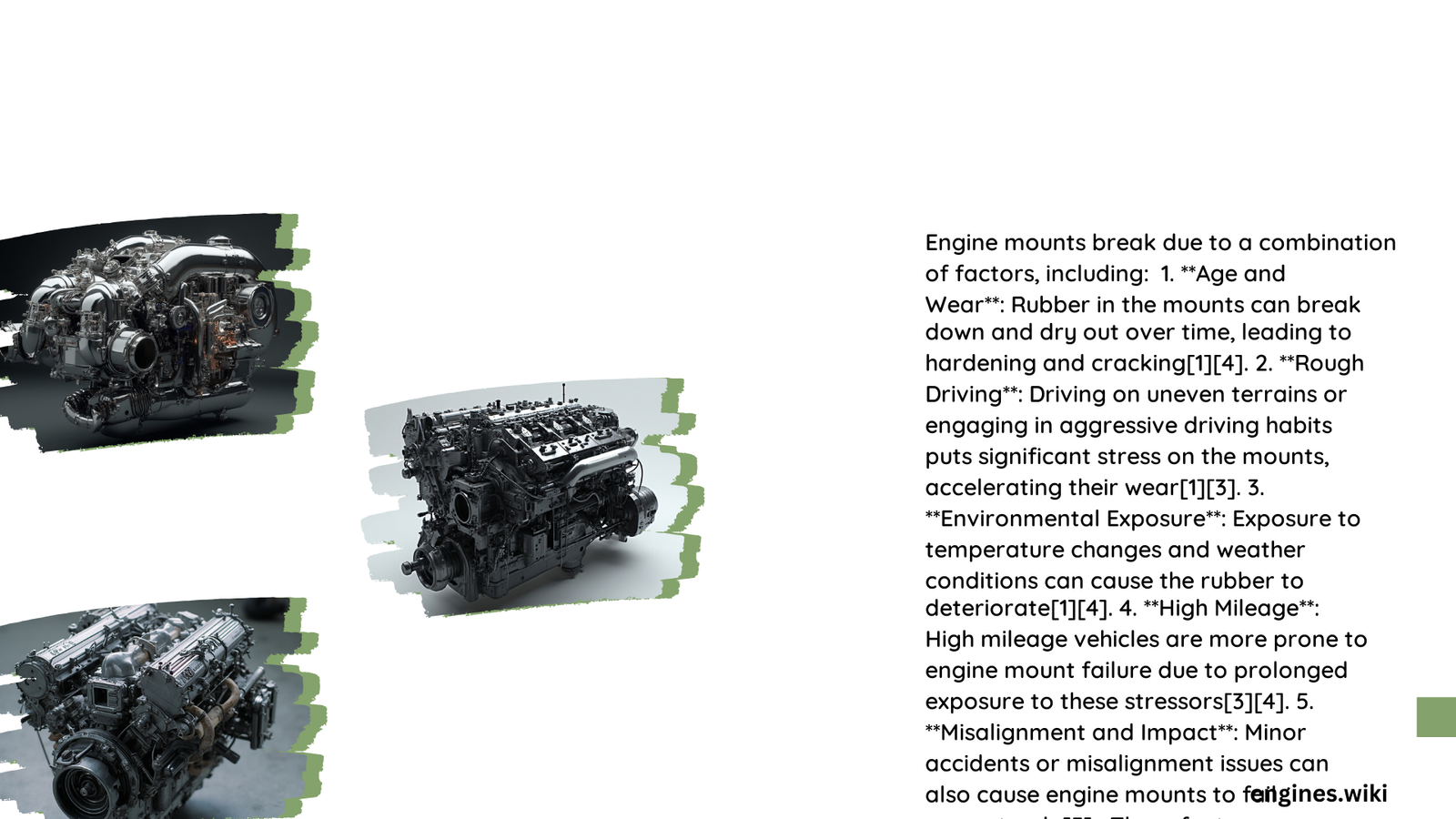Engine mounts are crucial components that secure the engine to the vehicle’s frame, absorbing vibrations and preventing excessive movement. Various factors can lead to their failure, including aging, aggressive driving, impacts, and environmental conditions. Understanding what breaks engine mounts is essential for maintaining vehicle performance and safety. This article explores the primary causes of engine mount failure, their effects, and the costs associated with replacement.
What Are the Main Factors That Cause Engine Mount Failure?
Engine mount failure can be attributed to several mechanical and environmental factors:
- Aging and Wear: Over time, the rubber components of engine mounts deteriorate due to:
- Constant vibrations
- Extreme heat exposure
- Corrosion
-
Material brittleness
-
Aggressive Driving Habits:
- Rapid acceleration
- Hard braking
-
These actions increase torque and vibration stress on the mounts
-
Physical Impacts:
- Collisions (even at low speeds like 25mph)
- Hitting large potholes
-
Encountering road debris
-
Environmental Conditions:
- Rough roads with potholes or gravel
- Extreme weather fluctuations
How Does Excessive Engine Vibration Affect Engine Mounts?

Excessive engine vibration plays a significant role in the degradation of engine mounts:
-
Vibration Intensity: High-revving engines produce considerable force and vibration. Worn or poor-quality mounts fail to isolate these vibrations effectively.
-
Efficiency Reduction: The vibration isolation efficiency depends on the ratio between:
- Natural frequency of the isolation system (engine mount)
- Machine’s excitation forces
A greater ratio results in better vibration absorption. However, worn rubber isolation reduces this ratio, accelerating mount degradation.
What Are the Precise Causes of Engine Mount Breakage?
The specific causes of engine mount breakage include:
- Material Fatigue:
- Limited lifespan of rubber components
- Brittleness due to extreme temperatures
-
Constant exposure to vibrations
-
Engine Load Variations:
- Changes during acceleration or braking
-
Varying torque levels on the mounts
-
Design and Tolerance Issues:
- Improper alignment
- Exceeded design tolerances
- Inability to handle specific engine characteristics (mass moments of inertia, max output torque)
What Are the Costs Associated with Replacing Engine Mounts?
Replacing engine mounts involves various costs:
| Cost Type | Price Range | Factors Affecting Cost |
|---|---|---|
| Parts | $50 – $500+ | Vehicle type, mount quality |
| Labor | $100 – $500 | Job complexity, mechanic rates |
Additional Considerations:
– Replacement frequency: Typically every 80-100k miles
– Factors affecting lifespan:
– Driving conditions
– Vehicle usage patterns
– Exposure to harsh environments
How Can You Identify Signs of Engine Mount Failure?
Recognizing the signs of failing engine mounts is crucial for timely replacement:
- Excessive Engine Movement:
- Visible engine rocking during starts and stops
-
Engine shifting more than usual when accelerating
-
Unusual Noises:
- Clunking sounds when shifting gears
-
Banging noises from the engine bay
-
Increased Vibrations:
- Noticeable vibrations in the cabin
-
Steering wheel vibration at idle
-
Misaligned Engine:
- Engine sitting at an unusual angle
- Uneven gaps around the engine compartment
What Preventive Measures Can Extend Engine Mount Life?
To prolong the life of your engine mounts:
- Regular Inspections:
- Schedule routine checks of engine mounts
-
Look for signs of wear, cracks, or fluid leaks
-
Smooth Driving Habits:
- Avoid aggressive acceleration and braking
-
Maintain steady speeds when possible
-
Road Condition Awareness:
- Be cautious on rough roads
-
Avoid potholes and road debris when safe to do so
-
Proper Maintenance:
- Keep engine tuned for optimal performance
-
Address any engine issues promptly to reduce stress on mounts
-
Quality Replacements:
- Use high-quality OEM or equivalent mounts when replacement is necessary
- Consider upgrading to performance mounts for high-stress applications
By understanding what breaks engine mounts and taking preventive measures, you can extend their lifespan and maintain your vehicle’s performance and safety. Regular inspections and timely replacements are key to avoiding more serious and costly repairs down the road.
